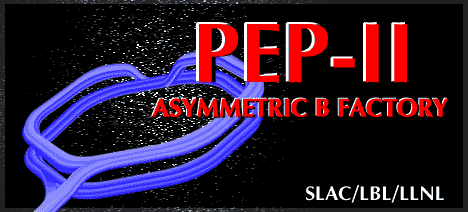 02/29/00 Update
02/29/00 Update  02/29/00 Update
02/29/00 Update PEP-II
resumed beam operation January 12, 2000, after a six-week down. The down was
needed to repair vacuum chambers in the interaction region which had opened
leaks at fixed masks from stress fatigue due to beam heating from synchrotron
radiation. The new repairs can take full power and heating cycles.
After
turn-on, the overall beam lifetimes were good as the vented fraction of each
ring was quite small. As expected, the vacuum levels in the interaction region
were high for a while during the first few weeks causing detector backgrounds
dominated by the HER beam. After a month of operation the average backgrounds
were down to the Fall 1999 levels if not slightly better.
However,
increased radiation bursting in BaBar occurred in January. PEP-II has always had
short (a second or two in duration) bursts of high radiation in BaBar. After
turn-on the bursting rate was three to four times worse. These bursts had
various amplitudes and timings (every five to ten minutes) associated with only
the HER ring. At first BaBar would abort the beams every ten minutes or so
leading to about 40 trips per day. With practice, injection has become very
efficient with a full injection from zero current taking about 10 minutes and a
top-off only 2 minutes. Fortunately, the aborts from bursts have decreased from
processing after six weeks of operation to about 15 per day and is approximately
what it was last fall.
The
cause of the bursts is not known. Tune jumps, RF glitches, and orbit moves have
been looked at carefully and mostly ruled out. Only local dust particles or
vacuum micro-bursts remain likely possibilities. The fact that the only
radiation signals during these events occur just inside the detector and no
where else indicates a very local effect. Some of the bursts remain as a
constant increased background level. One known hint is that the nearby vacuum
chambers had been reworked during the holiday
down. A test was performed by placing a small solenoid
"thumper" (one cubic inch) on the vacuum chamber upstream in the HER
between the Q4 and Q5 quadrupoles. By thumping the chamber very gently,
dust-like events were easily generated in BaBar with the same signature as the
real events. More studies will follow.
PEP-II
has established a weekly routine of one machine development day (Wednesday) and
six days of BaBar data collection. During machine physics studies the HER has
reached 920 mA in 1658 bunches and the LER 1720 mA. The HER has accumulated 812
A-hr and the LER 1576 A-hr. About 12% of the data is taken off the resonance
peak (40 MeV down).
Over
the past six weeks PEP-II has delivered about 1100 /pb and BaBar has logged
about 85% of that, bringing the totals to about 3333 /pb delivered and 2760 /pb
logged since May 1999. The peak luminosity of PEP-II has just recently been
raised to 1.45E33 /cm**2/s with 650 mA x 1000 mA and 829 bunches. The best
integrated luminosity is now 27.0 /pb for an eight hour shift and 74.2 /pb for
24 hours.
In
the near future we will try a LER wiggler off configuration, new LER tune
locations, and more bunches to try to increase the luminosity.
The
overall plan is to run continuously through August 2000 including a few repair
days, to be followed by a two month down in September and October.
John
Seeman for the PEP-II Staff 2/29/2000
Suggestions to: John Seeman
[PEP-II Commissioning Updates] [PEP-II Home Page] [BABAR Detector Home Page] [SLAC Home Page]
Page owner: achan